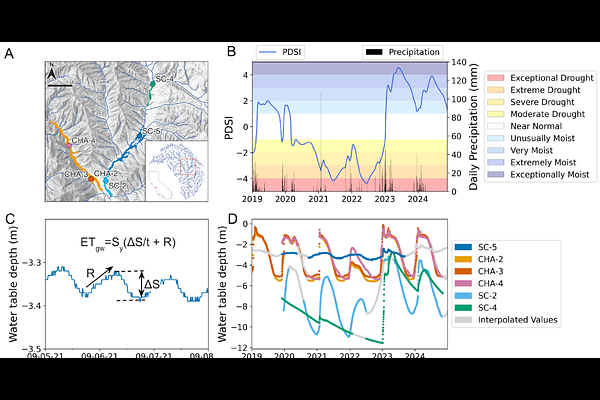Groundwater and phenology data reveal vulnerability of riparian trees to drought

Groundwater and phenology data reveal vulnerability of riparian trees to drought
Mohammadi, R. M.; Dawson, T. E.; Tiedeman, C. R.; Stella, J.; Ruhi, A.
AbstractThe increasing frequency and magnitude of climatic extremes are altering water availability in dryland ecosystems globally. However, riparian vulnerability to hydroclimate whiplash remains poorly understood. Here, we examined how riparian trees respond to groundwater fluctuations and drought through their water use patterns and phenology. To this end, we combined time-series analysis of long-term, high-frequency groundwater monitoring and satellite imagery from a drought-prone and relatively pristine watershed in California (Chalone Creek, Pinnacles National Park). We found that trees by intermittent river reaches displayed consistent but depth-limited groundwater reliance, while those at perennial reaches primarily relied on groundwater during the dry season. Machine-learning models revealed that at intermittent sites groundwater depth predominantly controlled vegetation greenness, represented by Normalized Difference Vegetation Index (NDVI). In contrast, variation in photoperiod length dominated at perennial sites where water was more reliably available. During the severe 2020-2022 drought, all species experienced reduced greenness, but phenological responses differed by flow regime. While the start of season was delayed across all sites, trees at intermittent reaches exhibited substantially earlier end of season during drought, resulting in growing seasons shortened by as much as 28 days. These phenological shifts vastly exceed those documented across aridity classifications in global datasets from satellite observations, ground-based monitoring networks, and experimental precipitation manipulations. Although riparian trees in drylands have been shaped by exposure to drought over evolutionary timescales, our findings challenge the prevailing assumption that ecosystems regularly exposed to hydrological are more resilient to drought. Instead, we show that trees in intermittent systems may be operating close to critical groundwater thresholds, rendering them particularly vulnerable to increasingly long and severe droughts.